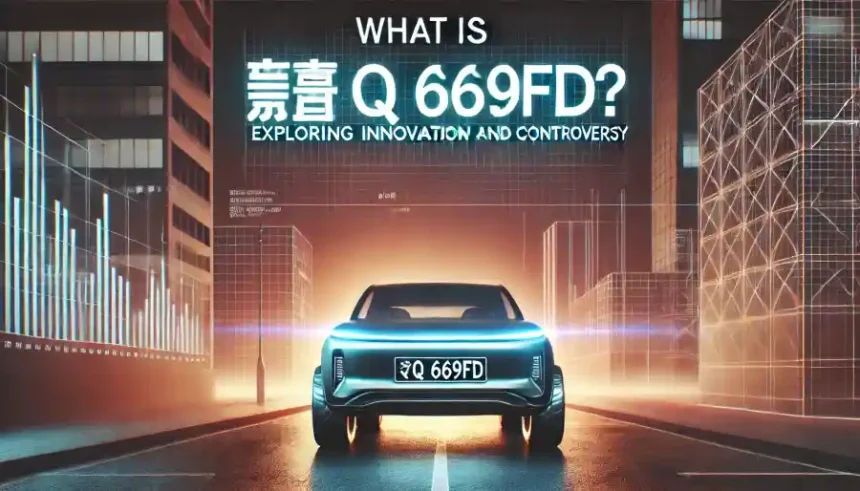Introduction to 鲁q 669fd
In an era where technology and innovation seem to be racing ahead at breakneck speed, new terms often emerge, capturing our curiosity. One such term that has recently gained traction is “鲁q 669fd.” But what exactly does it mean? Is it a revolutionary breakthrough or merely a fleeting trend? This enigmatic concept blends the excitement of innovation with the shadows of controversy, sparking discussions across various fields. Whether you’re curious about its origins, potential benefits, or even the criticisms surrounding it, delve into this exploration of 鲁q 669fd as we unravel its mysteries together. Prepare for an intriguing journey through the landscape of modern advancements!
History and Origins of 鲁q 669fd
鲁q 669fd emerged in the early 2020s, capturing attention for its innovative approach to technology. It was developed by a group of engineers seeking to combine efficiency with sustainability.
The concept originated from research aimed at enhancing user experiences while minimizing environmental impacts. Early prototypes were tested in various industries, showcasing their potential.
As word spread, interest grew internationally. Scholars and tech enthusiasts began exploring 鲁q 669fd’s implications in fields like artificial intelligence and renewable energy.
This blend of cutting-edge design and ethical considerations sparked debates among experts about its role in shaping future technological advancements. The origins reflect a larger trend towards responsible innovation, highlighting how necessity can drive creativity without compromising values.
The Controversy Surrounding 鲁q 669fd
The emergence of 鲁q 669fd has sparked heated debates across various sectors. Critics argue that its introduction could disrupt existing systems and create unforeseen challenges.
Concerns about ethical implications loom large. Many feel that the rapid advancement associated with 鲁q 669fd may outpace regulation, leading to potential misuse or unintended consequences.
Moreover, there are fears surrounding transparency. Some stakeholders question whether enough information is available for proper scrutiny. This lack of clarity fuels misinformation and skepticism among the public.
On social platforms, discussions often become polarized. Supporters highlight its innovative aspects while detractors focus on potential risks. This divide showcases a broader struggle between embracing technology and prioritizing caution in implementation.
As more individuals engage with 鲁q 669fd, these controversies will likely persist, shaping opinions and influencing future developments in this field.
Potential Benefits of 鲁q 669fd
鲁q 669fd offers intriguing possibilities across various sectors. Its unique formulation could enhance efficiency in processes where optimization is key.
One notable area of potential benefit lies in technology. 鲁q 669fd may streamline operations, reducing time and resources while maximizing productivity.
In healthcare, the innovation might lead to breakthroughs in treatment methodologies. Enhanced precision can improve patient outcomes significantly.
The environmental impact cannot be overlooked either. 鲁q 669fd has the potential to pave the way for sustainable practices, promoting eco-friendliness without sacrificing performance.
Moreover, its adaptability means that industries from manufacturing to digital platforms could harness its capabilities uniquely tailored to their needs. This level of versatility makes it an exciting prospect for future development and investment.
Criticisms and Risks of 鲁q 669fd
Critics of 鲁q 669fd point to potential privacy concerns as a significant issue. The technology’s ability to collect vast amounts of data raises alarms about how this information is managed and protected.
Another concern revolves around ethical implications. Many fear that the innovation could be misused, leading to unintended consequences in various sectors, including healthcare and security.
Moreover, there are worries about its impact on employment. As automation becomes more prevalent through 鲁q 669fd, jobs may be at risk, creating economic instability for many workers.
Regulatory challenges loom large. Governments struggle to keep pace with rapid technological advancements like 鲁q 669fd. This gap might lead to inadequate protections for users and the environment alike.
The Future of 鲁q 669fd
The future of 鲁q 669fd remains a topic of fierce debate. As technology advances, it’s likely that we will see further developments in its applications. Innovators are eager to explore new possibilities.
Industry experts predict that 鲁q 669fd could revolutionize several sectors, from healthcare to manufacturing. This potential could lead to enhanced efficiency and productivity across various fields.
However, regulatory frameworks are still catching up with the rapid pace of innovation surrounding 鲁q 669fd. Striking a balance between fostering creativity and ensuring safety is essential for sustainable growth.
Public perception will play a significant role as well. How people view both its benefits and risks may influence future investment and research directions.
The trajectory of 鲁q 669fd hinges on collaboration among technologists, regulators, and society at large. Only time will reveal how these dynamics unfold.
Conclusion: Is 鲁q 669fd an Innovation or a Controversy?
鲁q 669fd stands at a crossroads of innovation and controversy. The discussions surrounding it reveal deep divisions in opinion. Some view it as a groundbreaking advancement, while others raise significant concerns.
The potential benefits are enticing but come with caveats. Advocates emphasize the transformative impact on various sectors, touting efficiency and progress. However, skeptics highlight ethical dilemmas and unintended consequences that could emerge.
Debate continues to swirl around its implications for society. As research develops and more applications surface, clarity may arise about 鲁q 669fd’s true nature. Is it paving the way for future advancements or creating new challenges?
As stakeholders grapple with these questions, the narrative remains fluid. Perspectives will evolve as understanding deepens, making this topic one to watch closely in coming years.
FAQs
鲁q 669fd has certainly sparked a range of discussions and viewpoints. It stands at the crossroads of innovation and controversy, captivating those curious about its potential impact on society. With roots that trace back to specific technological advancements, it’s clear that 鲁q 669fd is not just a fleeting trend.
The ongoing debates surrounding its implications reveal deep-seated concerns as well as hopeful prospects. While some herald the benefits it could bring to industries and everyday life, others caution against the risks involved in adopting such innovations without thorough scrutiny.
As we look ahead, it’s essential to monitor how 鲁q 669fd evolves within both technological realms and public perception. Will it foster positive changes or become an example of what happens when innovation outpaces regulation? The coming years will be crucial for understanding where this journey leads.
FAQs
Q: What exactly is 鲁q 669fd?
A: 鲁q 669fd refers to a cutting-edge technology that blends artificial intelligence with various applications across sectors like healthcare, finance, and more.
Q: Is 鲁q 669fd safe to use?
A: Safety remains a topic of debate due to varying opinions regarding its ethical implications and potential risks associated with misuse.
Q: How can I benefit from using 鲁q 669fd?
A: Businesses may find opportunities for efficiency improvements while individuals might experience enhanced services tailored to their needs through personalized solutions offered by this technology.
Q: Are there regulations governing 鲁q 669fd?
A: Currently, regulatory frameworks are still catching up with rapid advancements like 鲁q 669fd; thus far, oversight varies significantly by region and application area.
Q: What are experts saying about the future of 鲁q 669fd?
A: Experts hold differing views: some advocate for embracing its innovations while others warn against overlooking necessary safeguards that protect users’ privacy rights.

















